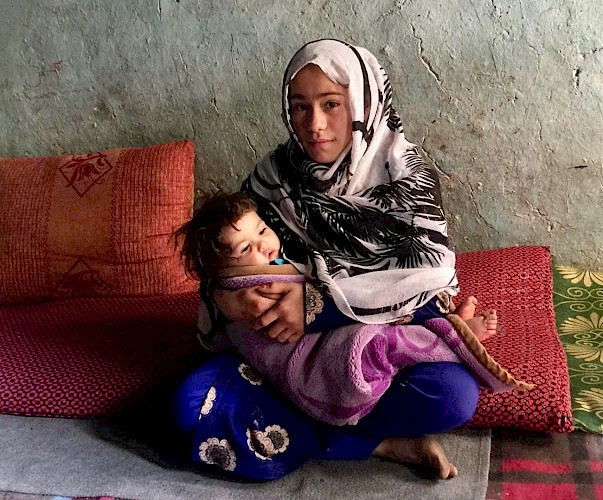Engaging Afghan men at a societal level to increase women’s access to contraception
—
Abstract
Most of culture lies hidden and is outside voluntary control, making up the warp and weft of human existence. Even when small fragments of culture are elevated to awareness,
they are difficult to change.– Edward T. Hall, The Hidden Dimension
Introduction
In many societies, the cultural norm is for men to be the predominant decision makers. But Afghan culture is based on a male-dominant structure, which means that essentially all major decisions, including intimate ones directly impacting a woman’s health, are made by men. In the context of pregnancy and childbirth, this pattern of decision making directly contributes to avoidable mortality and morbidity. Men’s lack of knowledge regarding the use of contraception to achieve healthy birth spacing and limit family size, coupled with their reticence and belief in their right to decide, directly impacts the health and well-being of their wives and offspring.
This precarity for women is magnified among the increasing numbers now forced to flee their homes and live in camps either as internally displaced persons (IDPs) or as refugees. The United Nations Commissioner for Refugees (UNCR 2019) estimates that, in today’s world, political strife and global conflict mean that an unprecedented 70.8 million men women and children around the world are displaced in this way.
Challenges, approach, and objectives
This photo essay illustrates one response to an international call for ‘bold ideas’ to reduce maternal and infant mortality made by Grand Challenges, Canada, a nonprofit organization that uses the Grand Challenges model in global health. This model was developed by the Bill and Melinda Gates Foundation to fund solutions to critical health and development challenges in the developing world. A team from Rose Charities Canada collaborated with the Tabish organization in Afghanistan to design a societal intervention targeting men, with the objective of improving women’s access to contraception in IDP camps in Afghanistan. Tabish is an Afghan nongovernmental organization (NGO) that Rose Charities Canada supports; Tabish staff are Afghan nationals whose services include provision of basic medical and midwifery services that would otherwise be lacking in the camps they serve; consequently, these men and women have become accepted and valued members of these camp communities. Rose Charities Canada has supported Tabish for several years, and responded to the ‘call’ based on the intimate knowledge Tabish staff have of the cultural, social, and practical challenges faced by women in the camps.
Mother and child mortality rates in Afghan IDP camps are among the highest in the world. Most women there have babies that are unplanned, and many also marry as teenagers (image 1) and have pregnancies close together (image 2), so that the health of the mothers and their newborn infants suffers (Bartlett et al. 2005).[note 1]
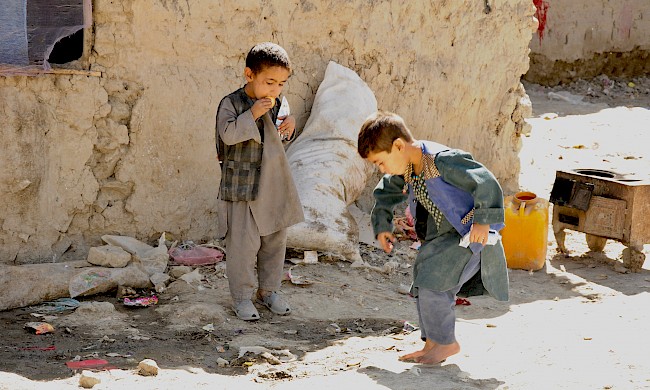 2. Most children born in the camps are unplanned; minimal birth spacing and large numbers of children compromise maternal health and cause practical, emotional, and financial burdens for families. Qala Wahid, Afghanistan, 2017.
2. Most children born in the camps are unplanned; minimal birth spacing and large numbers of children compromise maternal health and cause practical, emotional, and financial burdens for families. Qala Wahid, Afghanistan, 2017.The literature indicates that unintended pregnancies and minimal birth spacing compromise maternal and infant health, and place practical and financial burdens on the family (Tsui et al 2010; Rutstein et al. 2005). In parallel, poverty, stress, and the risk of family violence increase (Thomas and Thomas 2004). While globally the use of family planning is proven to significantly lower maternal mortality and morbidity from unintended pregnancy, knowledge, access, and empowerment are required if women are to benefit from family planning. However, because in Afghan culture health decisions are made by men, conventional health promotion focused on women can only have limited success (image 3). Because of these societal factors we designed an intervention to engage men in a way that respected their place in society by convening men’s groups where trained elders could lead discussion about the practical, financial, and health benefits of contraception. The aim was to instil a level of understanding that had the potential to change the men’s attitudes and behaviour around the use of contraception. The ultimate objective was for this to translate into them being able to initiate informed dialogue with their spouses or respond positively if their wives inquired about contraception.
We believe taking photos is important when conducting an intervention such as this, as the images are a way to convey unique ethnographic aspects of life and capture integral elements of ‘what works and why’ when evaluating an intervention (Macnab, Kasangaki, and Cannon 2012). Tabish staff provided the images for this photo essay; they took photographs throughout this project, continuing a long-standing practice of using photography and video to document their work in the IDP camps. The photographs serve as a way of giving insight to individuals and agencies unable to see their care delivery model and constituency first hand. Their ability to obtain permission and take such candid images stems from the unique trust and rapport Tabish has developed among those that they care for in the camp communities. Prior to and during this project, such photos enabled members of our team unable to be in Afghanistan to appreciate the richness and complexity of life in the community.
 3. Men and their sons hold a pre-eminent position in Afghan society. Quala Wazir, Afghanistan, 2018.
3. Men and their sons hold a pre-eminent position in Afghan society. Quala Wazir, Afghanistan, 2018.Tabish staff had observed through being in the community that, while husbands often tacitly agreed with wives who wanted no more children, most admitted to male confidants that they did not know what to do about it. They also learned that fears and misconceptions were rife around contraception; for example, men wondered whether it was somehow anti-Islamic or dangerous. Compounding this, they detected an underlying social taboo on speaking about contraception or asking for advice. Tabish staff were ideally placed through their prior involvement in health support roles while working with IDPs to undertake the training of respected elders from the camps; men’s group leaders were taught what facts to share, how to lead discussion, and to engage imams to add doctrinal clarity and religious endorsement (image 4).
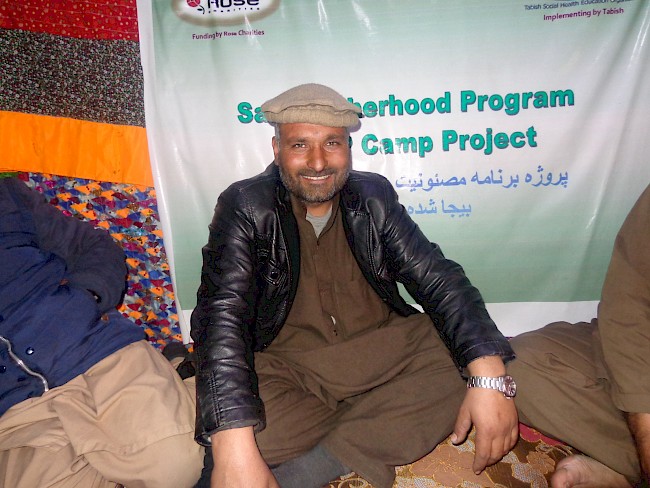 4. A respected member of the Tabish NGO staff who trained the men’s group leaders and imams for this project. Dasht Barchi, Afghanistan, 2017.
4. A respected member of the Tabish NGO staff who trained the men’s group leaders and imams for this project. Dasht Barchi, Afghanistan, 2017.Outcome of societal intervention
Three hundred families not currently using contraception were recruited in each of three IDP camps. Sixty group leaders (elders and imams) were trained so that weekly groups could be offered at several locations in each camp over the one-year intervention. Tabish staff provided culturally appropriate, evidence-based information for these group leaders to share and demonstrated how to facilitate respectful discussion. Tabish medical and midwifery staff (image 5) collected data on group attendance and the number of women and men seeking contraceptive advice and supplies, engaged in photographic documentation of events, and gathered information via interviews and questionnaires on participants’ knowledge acquired and changes in attitude/behaviour, including spousal dialogue.
 5. A Tabish midwife examines an Afghan mother. Tabish midwives trained traditional birth attendants to provide information, assessment, and contraceptive supplies to the participating women in the IDP camps. Sharak Mohamedia, Afghanistan, 2018.
5. A Tabish midwife examines an Afghan mother. Tabish midwives trained traditional birth attendants to provide information, assessment, and contraceptive supplies to the participating women in the IDP camps. Sharak Mohamedia, Afghanistan, 2018. 6. An imam leads a discussion with a men’s group. Fears and misconceptions were rife around contraception; a key element in the success of the men’s group model was the inclusion of imams to address unfounded religious concerns. Qala Wahid, Afghanistan, 2018.
6. An imam leads a discussion with a men’s group. Fears and misconceptions were rife around contraception; a key element in the success of the men’s group model was the inclusion of imams to address unfounded religious concerns. Qala Wahid, Afghanistan, 2018.Men’s groups were held weekly for one year (image 6). Some of the notable results include: 664 of 900 men (74 percent) participated in at least six sessions, 840 (93 percent) of the women who participated women reported beginning regular use of contraception, and 264 men (29 percent) sought family planning products for the first time. The evaluation by Tabish staff found that most men reported acquiring new knowledge and that elements of their attitude toward contraception had changed. Among the women seeking contraceptives, many reported they were doing so because they had been able to have an effective dialogue with their husbands and/or had received recent spousal approval to do so (image 7). Participants’ feedback also suggested that a man’s mother may influence his decision making around family matters, and therefore affect a woman’s access to contraception (image 8).
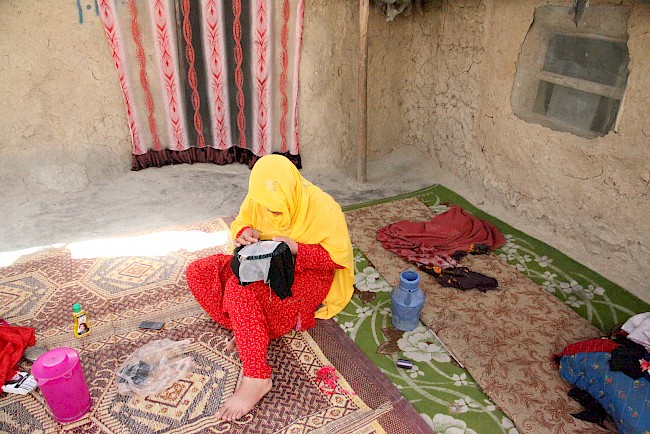 7. Our evaluation found that many women seeking contraception did so following conversations with their husbands, and that women who created handicrafts that generated income had some freedom to choose which family planning products they decided to use after gaining their husbands’ permission. Dasht Barchi, Afghanistan, 2018.
7. Our evaluation found that many women seeking contraception did so following conversations with their husbands, and that women who created handicrafts that generated income had some freedom to choose which family planning products they decided to use after gaining their husbands’ permission. Dasht Barchi, Afghanistan, 2018.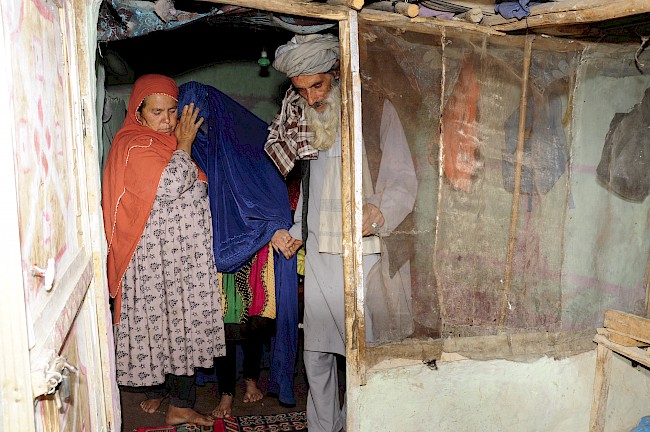 8. An unexpected lesson learned was the influential role mothers-in-law can play indirectly with regard to the health of their daughters-in-law; this is because their place in Afghan society gives them the ability to inform and influence their son’s decision making. Sharak Mohamedia, Afghanistan, 2018.
8. An unexpected lesson learned was the influential role mothers-in-law can play indirectly with regard to the health of their daughters-in-law; this is because their place in Afghan society gives them the ability to inform and influence their son’s decision making. Sharak Mohamedia, Afghanistan, 2018.Impact and relevance
There was evidence of the initiative’s impact on the broader community as well, as women who were not part of the intervention cohort also sought family planning advice from Tabish staff. This ‘trickle down’ effect is a recognized benefit of effective health promotion within the community as a whole (Macnab, Gagnon, and Stewart 2014). The feedback from one woman strongly supports this premise: ‘The whole atmosphere in the camps towards family planning has changed. It is no longer a taboo subject’.
Cultural norms shape how people think about the world and influence their behaviour. The success of this intervention indicates that benefits can accrue from recognizing where the dominance of gender impacts adversely on health, and that promoting appropriate knowledge based on societal insights can sufficiently inform and empower participants to influence behaviour.
Measures to improve women’s access to contraception and sustain its use are called for, and health promotion to change behaviours related to family planning are widely promoted (Tsui et al. 2010; Rutstein 2005; Bolam et al. 1998), but while the rhetoric of ‘engaging men’ is longstanding, and the intention is to empower women and reduce the negative impact of men’s bias and behaviour (Sternberg and Hubley 2004), there is limited evidence of the impact of male-centred interventions. Targeting men has increased uptake of modern contraceptives in Ethiopia, and lowered spouses’ discontinuation rates in Bangladesh (Shattuck et al. 2004). In addition, links are reported between male involvement in health promotion and increased contraceptive use (Sternberg and Hubley 2001), and, in a separate study, between couples’ programs and improved interspousal communication and decision making around contraception (Becker 1996).
Conclusion
Key elements underlying the success of our approach targeting men were the insights gained by Tabish staff through their long-standing contact with camp communities, the ability of the men’s group leaders to articulate relevant and effective messages through dialogue, and the ability of the imams to establish religious acceptance (image 6). We found that learning of the economic benefits of using contraception to achieve longer birth spacing and smaller families was more compelling to these men, as an argument for change, than any maternal or child health benefits. This parallels research in Uganda that found that the economic benefits of having a healthy child, rather than one at risk of developing a chronic noncommunicable disease (NCD), were seen as more important than any other benefits. A challenge for implementing any health promotion is how to engage the at-risk population. To identify how to interest twelve- to fifteen-year-olds in efforts to ensure the health of a future baby from conception to age two, pupils in three rural schools were asked to choose the most persuasive reason why they would take steps to be a good parent from a list of proven benefits associated with having a healthy child free of NCDs; the economic benefits of health were deemed the most compelling (Macnab and Mukisa 2018).
We suggest our male-centred model increased men’s knowledge, influenced their decision making, and promoted spousal dialogue. This intervention was simple, inexpensive, and culturally appropriate for Afghanistan and other Muslim countries. Given that it was implemented with local personnel, it could readily be translated to the many other IDP camps with similar need (there are more than three hundred in the proximity of Kabul alone). This model, which could readily be disseminated through effective advocacy, also answers the call for more male-centred initiatives (Becker 1996), and supports the argument that strategies in developing countries to improve maternal and child health should directly involve the at-risk community (Rosato et al. 2008).
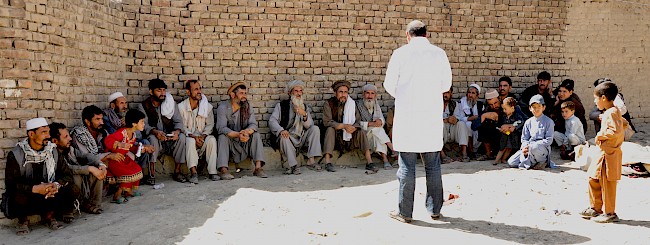 9. The participation of Afghan medical staff from Tabish and the level of respect they have earned in IDP camp communities were integral the design, delivery, evaluation, and success of this societal intervention. Qala Wahid, Afghanistan, 2017.
9. The participation of Afghan medical staff from Tabish and the level of respect they have earned in IDP camp communities were integral the design, delivery, evaluation, and success of this societal intervention. Qala Wahid, Afghanistan, 2017.Acknowledgements
This work was supported by a grant from Grand Challenges Canada [Grant Number R-ST-POC-1707-06340 Stars in Global Health], Rose Charities Canada, and the Stellenbosch Institute for Advanced Study, Stellenbosch, South Africa, through a fellowship award (AJM). We acknowledge the contributions made to this project by the families in the IDP camps, the staff of Tabish (Rose Charities Canada’s partners in Afghanistan), and Drs Amiri, Fayazi, and Yaldash of Tabish for delivery and evaluation components. Also, we thank the Afghan Ministry of Public Health for its support.
About the authors
Wais Aria is an Afghan physician who directs the NGO Tabish in its work in IDP camps in Kabul. Tabish staff are Afghan volunteers who provide basic medical and midwifery services in camps that would otherwise not be available. Dr Aria and Tabish staff have unique experience in the cultural and social fabric of IDP camps and the challenges faced by families; this intimate knowledge and their insights were central to the design of the intervention delivered. Aspects of Dr Aria’s humanitarian work have been selected for funding by several major agencies in the past. Dr Aria led our team and the delivery and evaluation of the project described.
Josephine de Freitas is the executive director of Rose Charities Canada and a board member for the Hillman medical education fund. She has many years of experience administering projects, funded by major agencies such as the Optimus Foundation and the Canadian International Development Agency, to help societies around the world. She has collaborated with Tabish to expand their services in IDP camp communities in Afghanistan and led the liaison of the Rose Charities team members working remotely from Canada with Tabish staff on the ground in Afghanistan. She helped conceive this project and also directed administration of the required financial support and logistics.
Maggie Francis is the board chair of Rose Charities Canada and a long-standing champion of Tabish, and the rights of women and children in Afghanistan and the many other countries where Rose Charities projects are benefiting communities. With a background in the provision of social services she brings a unique perspective to international aid. She was instrumental in translating Tabish’s observations of the social and cultural interactions influencing women’s life in the camps into an effective intervention.
Andrew Macnab is a Canadian paediatrician and an award-winning researcher with a reputation for innovation and excellence. Many of his initiatives involving novel approaches and the application of leading-edge technology to improve health care delivery have been adopted nationally and internationally. He is the founder of the child global health program Brighter Smiles Africa, a Rose Charities Canada project, and is a Grand Challenges Canada Star in Maternal, Child and Infant Health. He has more than fifty years’ experience developing, delivering, and evaluating aid projects in international communities. He helped conceive and design this project.
References
Bartlett, Linda A., Shairose Mawji, Sara Whitehead, Chadd Crouse, Suraya Dalil, Denisa Ionete, Peter Salama, and Afghan Maternal Mortality Study Team. 2005. ‘Where Giving Birth Is a Forecast of Death: Maternal Mortality in Four Districts of Afghanistan, 1999–2002’. Lancet 365 (9462): 864–70. https://doi.org/10.1016/S0140-6736(05)71044-8.
Becker, Stan. 1996. ‘Couples and Reproductive Health: A Review of Couple Studies’. Studies in Family Planning 27 (6): 291–306. https://jstor/stable/2138025.
Bolam, Alison, Dharma S. Manandhar, Purna Shrestha, Matthew Ellis, and M. de L. Anthony. 1998. ‘The Effects of Postnatal Health Education for Mothers on Infant Care and Family Planning Practices in Nepal: A Randomised Controlled Trial’. BMJ 316 (7134): 805–811. https://doi.org/10.1136/bmj.316.7134.805.
Hall, Edward T. 1990. The Hidden Dimension. 1st edition. Harlow, UK: Anchor Press.
Macnab, Andrew J., Faith A. Gagnon, and Donald Stewart. 2014. ‘Health Promoting Schools: Consensus, Strategies, and Potential’. Health Education 114 (3): 170–85. https://doi.org/10.1108/HE-11-2013-0055.
Macnab Andrew J., Arabat Kasangaki, and Wendy Cannon. 2012. ‘Videotaped Interviews as a Medium to Enhance Program Evaluation’. Health Promotion International 27 (1): 74–81. https://doi.org/10.1093/heapro/dar098.
Macnab, Andrew J., and Ronald Mukisa. 2018. ‘Priorities for African Youth for Engaging in DOHaD’. Journal of Developmental Origins of Health and Disease 9 (1): 15–19. https://doi.org/10.1017/S2040174417000423.
Rosato, Mikey, Glenn Laverack, Lisa Howard Grabman, Prasanta Tripathy, Nirmala Nair, Charles Mwansambo, Kishwar Azad, et al. 2008. ‘Community Participation: Lessons for Maternal, Newborn, and Child Health’. Lancet 372 (9642): 962–71. https://doi.org/10.1016/S0140-6736(08)61406-3.
Rutstein, Shea O. 2005. ‘Effects of Preceding Birth Intervals on Neonatal, Infant and Under‐Five Years Mortality and Nutritional Status in Developing Countries: Evidence from the Demographic and Health Surveys’. International Journal of Gynecology & Obstetrics 89 (S1): S7–24. https://doi.org/10.1016/j.ijgo.2004.11.012.
Shattuck, Dominick, Brad Kerner, Kate Gilles, Miriam Hartmann, Thokozani Ng’ombe, and Greg Guest. 2011. ‘Encouraging Contraceptive Uptake by Motivating Men to Communicate about Family Planning: the Malawi Male Motivator Project’. American Journal of Public Health 101 (6): 1089–95. https://doi.org/10.2105/AJPH.2010.300091.
Sternberg, Peter, and John Hubley. 2004. ‘Evaluating Men's Involvement as a Strategy in Sexual and Reproductive Health Promotion’. Health Promotion International 19 (3): 389–96. https://doi.org/10.1093/heapro/dah312.
Thomas, Samantha L., and Stuart D. M. Thomas. 2004. ‘Displacement and Health’. British medical Bulletin 69 (1): 115–27. https://doi.org/10.1093/bmb/ldh009.
Tsui, Amy O., Raegan McDonald-Mosley, and Anne E. Burke. 2010. ‘Family Planning and the Burden of Unintended Pregnancies’. Epidemiologic Reviews 32 (1): 152–74. https://doi.org/10.1093/epirev/mxq012.
United Nations Commissioner for Refugees. 2019. ‘Figures at a Glance’. https://www.unhcr.org/uk/.
Endnotes
1 Back
The (identifiable) people photographed have given written consent for their pictures to be used in the dissemination and publication of this research.
